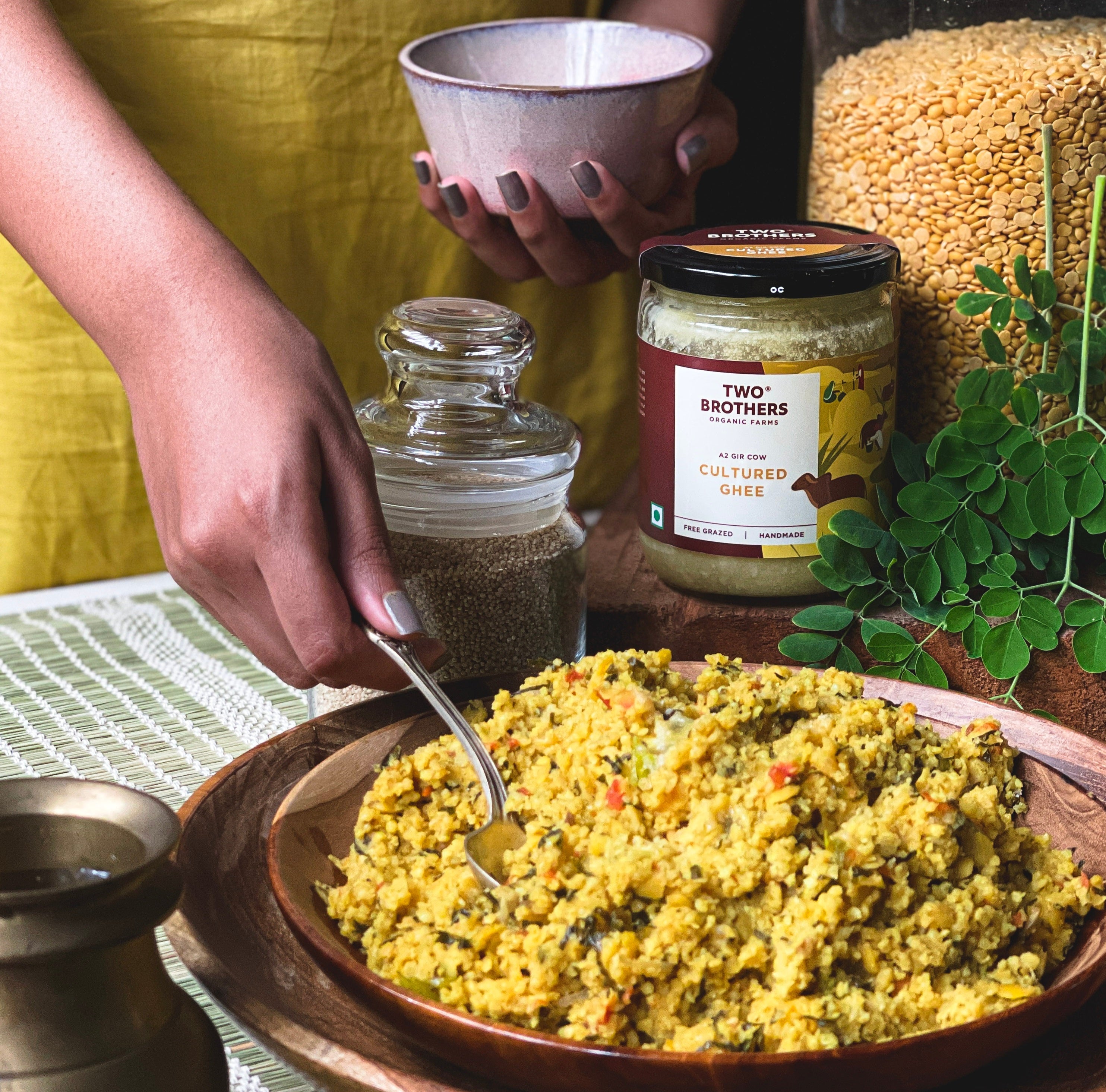At one point in time when eating consisted mostly of foraged foods, rain-fed ragi was what the ladies of the home waited for the tribals to bring from the forest. Ragi, like most millets, grew with little care and flourished during the monsoons. With climate change becoming a reality in our lives, we have to encourage the cultivation and production of native foods so that the Earth can reclaim soil health.
There’s a lot more that goes on with that satiny smooth ragi porridge in your breakfast bowl than a delicious morning meal. It connects back to a food heritage which involved complex processes to make native grains suitable for digestion, absorption and nutrition.

Ragi malt is a fine powder which resembles the colour of powdered milk chocolate. The aroma when it is stirred with water over a slow fire, on the stove, envelopes you with a mix of emotions ranging from hunger, affection, longing and joy. It’s not an exaggeration by any means…the fragrance is pure comfort in food vapour!
The word ‘malt’ makes us think of sweet foods. In the edible dictionary of food descriptions, malt is used to describe caramely, molasses-like flavours which add a special depth to the sweetness.
‘Ragi malt’ is achieved through a series of processes where the ragi grain is allowed to mature and develop both nutrition and taste to the optimum.
So what is Malting?
Ragi or Finger Millet is cleaned, washed thoroughly and left to soak for 20-24 hours. It is then sprouted over the next 24 hours in clean cotton cloths, further sun-dried and milled in stone grinders. The sprouted ragi flour is then passed through a cotton cloth sieve to get fine sprouted-ragi malt. Sprouting millets is an excellent method to enhance nutrition from millets. Sprouting after soaking removes all anti nutrients and makes them extremely easy to digest and absorb.
Ragi, which most indian mothers swear by, is known for its ability to add bone and muscle strength while accelerating growth from the weaning stage to that of adolescence. It is hard to believe, for others, that lowly ingredients, so easy to grow for the farmer, can be capable of fortifying health to such a large extent.

We have long since been aware that sprouting grains helps immensely in digestion and absorption. For ragi to be made into the fine powder we all love, it is first soaked and allowed to sprout.
The sprouted ragi is sun dried, the traditional way. Modern technology has allowed us to apply the washing machine-dryer option to processing our foods as well. In doing so we forget the role of the sun in not just drying our foods but also adding to the preservation of the foods. Sun drying is an ancient technique used to preserve foods while adding to the nutritional intake.This is done by using the right amount of sun as well as the shade to keep the nutrition in the grains, intact. Sustainable food producers continue to follow the same process of natural drying without using machine dryers which only give off heat and no extra benefits.
The sun dried ragi sprouts are then ground, by hand, to a powder. This powder will be slightly coarse and not as fine as the final product. To achieve the super fine ragi malt powder, the finest muslin cloths come out to be used in the last process. The powder is gently sieved and driven through the fabric. Just knowing the manufacturing techniques involved, gives a deeper insight into just how valuable this ingredient is. It is suitable for both children and adults and is the fairy godmother of health and well-being.
The icing on the cake is the taste! We have to face it; all of this, in the longterm, is of little use if the taste is a letdown. Fortunately with ragi, as mentioned before, the aroma itself ropes you in. It is fantastic in both sweet dishes as well as anything savoury; whether a breakfast, snack or dinner.
Pick from ragi vadai, eaten with piping hot ginger tea, flavoured with onions, green chillies and curry leaves mixed with soaked ground chana dal; then there is the Nachni Sarva thalipeeth which again has a mix of lentils, subzi, herbs and spices…simply delicious! The ragi malt powder can be added to just about any batter of choice; while making dosa, pancakes, brownies, thepla, delicious laddoos using Ghee to combine the ingredients etc
There’s one very special and extremely simple recipe which is so insanely good and that is the ragi hot chocolate. It is one of the best kept secrets of the vegan world. The ragi malt powder when cooked with water adds the sweetness and creaminess of milk and elevates the pure chocolate or cocoa powder to a drink so heavenly that it is hard to believe that it is healthy. It is one of the most indulgent ways to enjoy the ragi malt powder.
The favourite of all has to be the Nachni laddoo. As much as we go exploring other cuisines and fill our appetite with different foreign tastes, the pull of our heritage kitchens is hard to resist. And that’s the way it should be, especially if we want to bake our cake and eat it too.
We are all watching our desi ladoos take on the avatar of protein rich bliss balls. The name really doesn’t matter as long as the ingredients going in are of native origin and sourced conscientiously. We can make our peace with ragi bliss balls as a post workout snack if it means adding ragi malt to your regular food intake list.
The recipe for the same varies with each household. Enterprising home cooks these days love to add dates instead of sugar and maybe even a dash of cocoa powder to the nachni flour, to call on those chocolate cravings! These simple homemade ladoos are easy to make and are a joyful chore when it turns into an activity which the entire family can enjoy. Food is meant to be a bonding factor not just when eating but also in preparation. This is how recipes get passed on along with the memories of time spent together.

The easiest nachni laddoo uses ragi malt roasted in ghee. Jaggery is added when the nachni flour is still warm and the mixture is fisted into rounds quickly before it cools. The jaggery melts in the heat from the roasting and the warmth of the palm and binds the ragi powder. We add raisins, gondh and Khareek too, to the Nachni laddoos we make at TBOF.
Other additions include roasted and powdered peanuts, grated and toasted coconut, toasted sesame, cardamom for aroma and maybe even some bits of mishri. The key ingredients however are desi ghee, jaggery and ragi malt.
As far as superfoods go, ragi is one of the easiest to include with regard to availability and versatility of recipe combinations. There are breakfasts in Kerala which are famous for the steamed ragi puttu with fresh grated coconut, jaggery and ghee. The cooking technique and visual appeal of the dish may differ from region to region but the ingredients remain more or less the same.

With the nachni ladoo being such a delicious and easy snack to fall back on, there is absolutely no way that one will crave snacks which come loaded with everything which is toxic for our bodies. All that commercial food relies on is to pump products with additives and preservatives which get us addicted to mindless munching. A nachni ladoo a day is not a desi slogan to replace the apple mantra copied from the West. It is an ideal mix of taste and health, the likes of which protect mental and physical health.
Eat food which calls on the happy endorphins and smile your way forward to achieving your goals and dreams.












1 comment
Anita Kumari
Very informative
Very informative